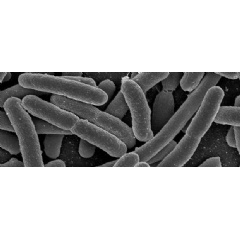New strategy could prevent GMO leaks from lab to the wild
Scientists rewrite bacterium’s genetic language so it can’t survive outside the lab

Scientists have crafted a bacterium incapable of surviving without human assistance. Using this strategy to build genetically modified organisms would prevent those GMOs from escaping into natural ecosystems, they say.
Genetically modified bacteria are commonly used in research and industry – for example, the bacterium E. coli is used to manufacture insulin and other drugs.
Whether bacteria could ever escape from those settings and wreak havoc in the natural world is unclear, but many members of the public feel containment strategies are necessary to prevent such a leak.
Scientists have tried many tactics to contain GMOs by manipulating their genes, but the bacteria eventually have found ways to evade those strategies, reverting back to their natural form. It became clear that any manufactured containment system would need multiple fail-safe layers.
Now, a team of scientists led by Dr. George Church of Harvard Medical School, involving collaborators at Fred Hutchinson Cancer Research Center, has created a molecular Fort Knox that they believe is evolution-proof, rewiring all of E. coli’s DNA to render the bug completely dependent on a synthetic chemical.
It’s like domesticating a wild creatureThink of it as the ultimate version of domesticating a wild creature – the organism’s dependence on humankind is now written into its very genes. Without the laboratory chemical, the engineered E. coli will die.
“They can’t get [that chemical] anywhere else in nature,” said Dr. Barry Stoddard, one of the authors of the study describing this strategy, which was published last week in the journal Nature. “That ensures that the bacteria can only function and survive in a laboratory setting.”
Taming E. coli this way was no simple task, said Stoddard, a structural biologist at Fred Hutch. It relied on two newly developed technologies – one to substantially re-engineer the bacterium’s genome, and a second to redesign several of its most essential proteins – that weren’t available just a few years ago.
First, the researchers altered the bacterium’s genetic code, co-opting one of E. coli’s instructions that tell the cells how to build its proteins. Instead of containing instructions for nature’s 20 amino acids, the building blocks of proteins, the modified bacterial DNA now codes for 21. That 21st building block is a synthetic amino acid only available in the lab.
That work, which Church’s team first described in an earlier study, was “in and of itself a remarkable thing to be able to do, to rewrite the genetic code of an organism that deeply,” Stoddard said.
Although that rewriting is itself a kind of genetic modification, it goes beyond many of the relatively simpler strategies used to make GMOs, to the point where Church and his colleagues named the resulting bacteria “genetically recoded organisms,” or GROs.
In their latest work, Church’s group worked with Stoddard’s team to build those artificial chemicals into the cores of several E. coli proteins. That “tour de force of protein engineering,” as Stoddard describes it, meant not only changing one amino acid, but altering the surrounding amino acids to make each redesigned protein completely dependent on the presence of the artificial piece.
‘At the fringe of stability’For this strategy to work, each redesigned protein “has to be right at the fringe of stability,” Stoddard said.
If any one of these essential proteins falls apart, the bacterium will die. So the researchers precisely engineered each protein so that if the E. coli mutated its rewritten DNA – the DNA that tells the cells to incorporate the artificial building block – the proteins would collapse in on themselves.
The approach seems to have worked. When the researchers tried to simulate conditions of lab escape, the bacteria couldn’t survive.
“Compared to other [genetic] strategies that have been used to try to ensure that bacteria can’t escape a laboratory, this one has extremely low, even undetectable, escape levels,” Stoddard said.
Those in industry and research could use their modified E. coli as a backbone to create safer genetically modified bacteria, GMOs less likely to escape the lab and overtake natural populations of bacteria. And while it’s easier to manipulate bacteria this way than it would be to build similar backbones for, say, GMO crops, it is theoretically possible, Stoddard said.
It’s unclear whether lab escapes are likely or have the potential to cause real danger, even if they did happen. But public concern about the possibility is strong enough that many researchers feel they should pursue containment strategies.
“You want to get ahead of these things, rather than wait until you have a problem,” Church said in an interview with the Los Angeles Times.
“Given the substantial concern about GMOs in general, I think it’s a wise area of investigation,” Stoddard said. “If you can engineer fail-safes into a GMO, regardless of whether they’re actually needed, then why not?”
Dr. Rachel Tompa, a staff writer at Fred Hutchinson Cancer Research Center, joined Fred Hutch in 2009 as an editor working with infectious disease researchers and has since written about topics ranging from nanotechnology to global health. She has a Ph.D. in molecular biology from the University of California, San Francisco and a certificate in science writing from the University of California, Santa Cruz. Reach her at rtompa@fredhutch.org.
( Press Release Image: https://photos.webwire.com/prmedia/7/195182/195182-1.jpg )
WebWireID195182
This news content was configured by WebWire editorial staff. Linking is permitted.
News Release Distribution and Press Release Distribution Services Provided by WebWire.